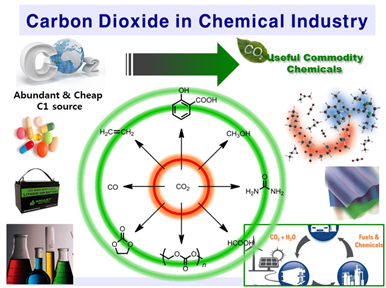
Research Theme
There is certainly a general consensus in the science and industrial communities that CO2 is one of the most inexpensive and renewable carbon resources, not only from green chemistry and environmental aspects, but also from the huge potential of industrial cost-effective resources. Thus, the development of efficient catalytic processes for the utilization of CO2 will have a tremendous direct impact in industrial chemistry. However, given the thermodynamics and kinetics of CO2 catalytic reactions, it is a major challenge in designing, evaluating, and finding more efficient catalysts for CO2 -insertion chemical transformations.
On the other hand, formic acid and CO are two major products from CO2 conversion. However, producing such a cheap chemical feedstock cannot be a practical solution due to the weak economic impact on the current industry. The direct conversion of CO2 into more valuable products such as organic carbonates and isocyanate is, therefore, required. In fact, organic poly- and cyclic-carbonates are widely employed for chemical, industrial, and pharmaceutical applications. According to a recent report, the world market of organic carbonates is estimated to be ~ $10 billion, with production of over 5 million tons per year. At present, 10% of the total products are being made through CO2 conversion. Thus, development of more effective catalysts is essential.
Isocyanate is another attractive chemical because it is a valuable synthetic precursor in polymer chemistry. The global market for 2,4-toluene diisocyanate (TDI) or methylene 4,4’-diphenyl diisocyanide (MDI), accounting for 95% of isocyanate demand, is currently estimated at ~$2.0 billion and still growing due to its high demand as a starting material for various polyurethanes. Due to the usage of highly toxic phosgene and production of corrosive materials such as HCl, alternative synthetic routes for the isocyanate industry are currently under investigation. A new method to accomplish the direct conversion of CO2 into desired isocyanate is currently needed.
Several catalysts, including metal oxides and coordination metal complexes, have been reported for the synthesis of cyclic carbonates by insertion of CO2 with epoxides. While some of these reports have shown good conversion and selectivity, most of the catalysts have at least one or two of the following problems: instability of the catalyst, mass production, expensive solvent and additives, high temperature and pressure, slow reaction kinetics, and reusability. Metal-salen complexes incorporating Cr(III), Co(III), or Al(III) are known to be effective.
Polyoxometalates are also a good candidate because of their catalytic flexibility for various applications.

- Key catalysts to be investigated
- Polyoxometalates (POMs)-based catalysts
- An inorganic single molecule composed of anionic metal oxides possessing multiple metal-oxo functional sites, of which redox properties can be readily maneuvered.
- Good physical & chemical properties: high temperature stability, solubility, and surface adsorption property.
- Low reaction rate for CO2 conversion is the main challenge.
※ Salen-based catalysts
※ Widely used for CO2 conversion in producing various organic carbonates and isocyanates due to their ease of synthesis and modification.
- Low catalytic stability/reactivity and high air sensitivity are the main challenges.
- Reusable catalysts attached to a heterogeneous support are currently limited.
- Major challenges
- Accelerating the slow reaction rate of POM-based catalysts via the optimal combination of transition metals and heterogeneous nanostructures.
- Enhancement of recyclability of salen-based catalysts for the production of organic carbonates without degrading their catalytic activity.
- High chemoselectivity in the production of poly- and cyclic-carbonates.
- Catalytic generation of isocyanates from CO2.
- Pre-screening of promising candidates using high-throughput computer modeling
- Fabrication & engineering of reusable catalysts
- Characterization of the fabricated hybrid systems


